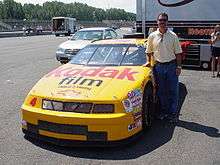Historic Stock Car Racing Series
The Historic Stock Car Racing Series (HSCRS) is an auto racing organization based on the west coast of the United States founded by San Jose, California businessmen John Davis in 1994 with a mandate to register, preserve, restore and continue showcasing authentic NASCAR Winston Cup Series stock cars in friendly competition.
The cars that are raced by HSCRS members are retired and now-privately owned Winston Cup stock cars, with a few Busch Grand National stock cars grandfathered into the group. The newest a HSCRS car can be is 1995. Owners/drivers who wish to join the HSCRS are required to demonstrate that their car is a verifiable NASCAR stock car that, with a few exceptions allowed on behalf of driver safety, has been restored to its original racing condition.
One of the foremost reasons for maintaining 1995 and older vehicles for the Historic Stock Car Racing Series is the continuing evolution in modern stock car technology since then (such as chassis, brakes, engine and aero improvements). These improvements make the contemporary cars able to go faster, stop quicker and turn better than the traditional, historic stock cars and leave the older cars far less competitive than their newer counterparts. Another concern is that allowing the last year of eligibility to also grow with each passing year of NASCAR competition would further water-down the "historic" nature of the HSCRS, the very principle of is origin. The feeling at the HSCRS is that it takes time to acquire historic or vintage significance and that if one wants to own and race a contemporary car that the venue for one is not the vintage circles or the Historic Stock Car Racing Series but in the pro ranks. When we bring our rolling pieces of NASCAR history out to the track we believe the car should be the show and not necessarily the current owner's individual driving talent or experience and that it doesn't really matter who finishes first. The only winners are the fans in the stands who are usually out of their seats and cheering when these cars take to the track.

The primary focus of the group are NASCAR stock cars built and raced 1995 and earlier, but they are further broken down into classes for reference:
- 1989 - 1995: Historic cars (110 inch wheelbase)
- 1981 - 1987: Chrome Bumper Classics
- 1980 and earlier: Vintage cars (full-size cars, notably 115 inches in wheelbase)
In the interest of cost containment, cars may use either roller camshafts (a type used in Busch Series and Craftsman Truck Series engines), or flat tappet camshafts (used in Nextel Cup engines). All cars using a roller camshaft must run a 10.0:1 compression ratio, slightly higher than the former 9.5:1 ratio mandated by NASCAR for those series. All cars using a flat-tappet camshaft must run with current NASCAR regulations mandating a 12.0:1 compression ratio, adopted in the late 1990s. Cars must also run bias-ply tires, despite Goodyear's four-season transition (1989–92) to radial tires. The first race with radials was the 1989 First Union 400 at North Wilkesboro, NC. The last bias-ply race was the 1992 Food City 500 at Bristol, TN. NASCAR has exclusively used radial tires since then, and with Bristol being the late track to go radial, with the August 1992 Bud 500) where later-model Historic cars (1986-88 Chevrolet Monte Carlo, 1990–94 Chevrolet Lumina, 1989-95 Ford Thunderbird, 1988–94 Pontiac Grand Prix, 1989-91 Buick Regal, and 1989-92 Oldsmobile Cutlass Supreme) all raced with radial tires, and Contemporary cars have only used radial tires.[1]

Prior to the formation of the HSCRS, the few existing owners/drivers of these historic race cars were limited to participating in Vintage Racing events, and were often relegated to sub-groups that paired the 3400-lb. machines with much smaller vintage race cars that ranged from diminutive European compacts to Shelby Mustangs, Corvettes and Cobras.
While this was initially done because there were not enough of the former NASCAR race cars to be treated as their own group, it revealed vast differences in speed and performance between the various types of cars. Although car-to-car contact is considered a grave offense in Vintage Racing (preservation of the vintage and historic race cars in lieu of cutthroat competition is paramount), racing accidents are inevitable. There began a growing concern that even minor contact between a massive purpose-built NASCAR racer and its smaller and lighter street-based counterpart could be devastating to the smaller car, and especially to the driver.
While the cars were originally raced in NASCAR-sanctioned events, the group is not associated with NASCAR. The businesses and corporations that once sponsored these cars do not provide any compensation to the current owners, nor do they assume any liability for the continued competition of these race cars. Still, the cars are maintained in their original livery for accurate historical representation. As such the group has wowed race fans at a number of venues including the San Jose Grand Prix, Mazda Raceway Laguna Seca, Portland International and Infineon Raceway where they have run as a support race group for Champ Car, The Daytona Prototypes, Camping World West Series and the SCCA Trans Am Series.
Of special significance is the HSCRS Ride of your Life (ROYL) program which, in the last 10 years, has raised over $400,000 for a variety of charities including the Canary Fund, Susan B. Komen Cancer Relief Foundation, 11-99 Foundation, The Boost Foundation of Sonoma County, The SPCA of Monterey County and the Cerebral Palsy Foundation of the North Bay. With the ROYL, winning bidders are given an E ticket ride at speed around a real race track in the passenger seat of one of the historic stock cars. It is the group's way of giving something back as they pay homage to the cars and drivers who helped make NASCAR what it is today.